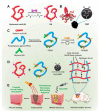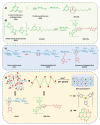Recent Advances of Natural-Polymer-Based Hydrogels for Wound Antibacterial Therapeutics
- PMID: 37571202
- PMCID: PMC10422483
- DOI: 10.3390/polym15153305
Recent Advances of Natural-Polymer-Based Hydrogels for Wound Antibacterial Therapeutics
Abstract
Hydrogels have a three-dimensional network structure and high-water content, are similar in structure to the extracellular matrix, and are often used as wound dressings. Natural polymers have excellent biocompatibility and biodegradability and are commonly utilized to prepare hydrogels. Natural-polymer-based hydrogels can have excellent antibacterial and bioactive properties by loading antibacterial agents or being combined with therapeutics such as phototherapy, which has great advantages in the field of treatment of microbial infections. In the published reviews of hydrogels used in the treatment of infectious wounds, the common classification criteria of hydrogels include function, source of antibacterial properties, type of antibacterial agent, etc. However, there are few reviews on the classification of hydrogels based on raw materials, and the description of natural-polymer-based hydrogels is not comprehensive and detailed. In this paper, based on the principle of material classification, the characteristics of seven types of natural polymers that can be used to prepare hydrogels are discussed, respectively, and the application of natural-polymer-based hydrogels in the treatment of infectious wounds is described in detail. Finally, the research status, limitations, and prospects of natural-polymer-based hydrogels are briefly discussed.
Keywords: antibacterial; hydrogel; natural polymer; wound healing.
Conflict of interest statement
The authors declare no conflict of interest.
Figures











Similar articles
-
Insight Into Bioactive Hydrogels for Wound Healing and Drug Delivery Systems.Curr Med Chem. 2021;28(42):8692-8710. doi: 10.2174/0929867328666210405125348. Curr Med Chem. 2021. PMID: 33820512 Review.
-
Design strategies for adhesive hydrogels with natural antibacterial agents as wound dressings: Status and trends.Mater Today Bio. 2022 Sep 15;16:100429. doi: 10.1016/j.mtbio.2022.100429. eCollection 2022 Dec. Mater Today Bio. 2022. PMID: 36164504 Free PMC article. Review.
-
Insights into the Role of Natural Polysaccharide-Based Hydrogel Wound Dressings in Biomedical Applications.Gels. 2022 Oct 12;8(10):646. doi: 10.3390/gels8100646. Gels. 2022. PMID: 36286147 Free PMC article. Review.
-
Hydrogel Combined with Phototherapy in Wound Healing.Adv Healthc Mater. 2022 Aug;11(16):e2200494. doi: 10.1002/adhm.202200494. Epub 2022 Jul 6. Adv Healthc Mater. 2022. PMID: 35751637 Review.
-
Tunicate-mimetic antibacterial hydrogel based on metal ion crosslinking and chitosan functionalization for wound healing.Int J Biol Macromol. 2023 Jul 31;244:125062. doi: 10.1016/j.ijbiomac.2023.125062. Epub 2023 May 27. Int J Biol Macromol. 2023. PMID: 37247717
Cited by
-
Recent Advances in Natural-Polymer-Based Hydrogels for Body Movement and Biomedical Monitoring.Biosensors (Basel). 2024 Aug 27;14(9):415. doi: 10.3390/bios14090415. Biosensors (Basel). 2024. PMID: 39329790 Free PMC article. Review.
-
Bioactive Polymer Materials with Antibacterial Properties: An Editorial.Polymers (Basel). 2025 Feb 1;17(3):394. doi: 10.3390/polym17030394. Polymers (Basel). 2025. PMID: 39940596 Free PMC article.
-
Failure or future? Exploring alternative antibacterials: a comparative analysis of antibiotics and naturally derived biopolymers.Front Microbiol. 2025 Feb 3;16:1526250. doi: 10.3389/fmicb.2025.1526250. eCollection 2025. Front Microbiol. 2025. PMID: 39963493 Free PMC article. Review.
-
Synthesis and Evaluation of Gelatin-Chitosan Biofilms Incorporating Zinc Oxide Nanoparticles and 5-Fluorouracil for Cancer Treatment.Materials (Basel). 2024 Jun 29;17(13):3186. doi: 10.3390/ma17133186. Materials (Basel). 2024. PMID: 38998269 Free PMC article.
-
Stimuli-responsive hydrogel based on natural polymers for breast cancer.Front Chem. 2024 Jan 18;12:1325204. doi: 10.3389/fchem.2024.1325204. eCollection 2024. Front Chem. 2024. PMID: 38304867 Free PMC article. Review.
References
Publication types
Grants and funding
- BPHR202203045/the project of Cultivation for young top-notch talents of Beijing Municipal Institutions
- KM202210011002/the Beijing Municipal Education Commission project
- hc202212/the Open Research Fund Program of Cultivation Project of Double First-Class Disciplines of Chemistry and Materials Engineering, Beijing Technology and Business University
LinkOut - more resources
Full Text Sources

